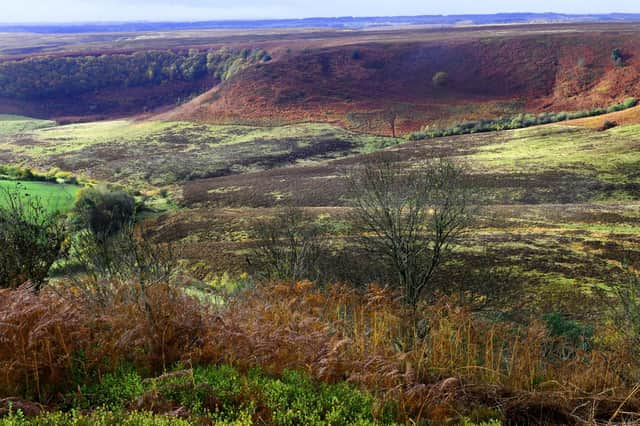Picture Post: Ferns turning brown at the Hole of Horcum


The Hole of Horcum is a section of the valley of the Levisham Beck, upstream of Levisham and Lockton, in the Tabular Hills of the North York Moors National Park.
The Hole of Horcum is one of the most spectacular features in the National Park – a huge natural amphitheatre 400 feet deep and more than half a mile across.
Advertisement
Hide AdAdvertisement
Hide AdLegends hang easily upon a place known as the ‘Devil’s Punchbowl’ – the best-known says that it was formed when Wade the Giant scooped up a handful of earth to throw at his wife during an argument.
It was actually created by a process called spring-sapping, whereby water welling up from the hillside has gradually undermined the slopes above, eating the rocks away grain by grain. Over thousands of years, a once narrow valley has widened and deepened into an enormous cauldron – and the process still continues today.
There is a spectaculr circular walk that takes in the Hole of Horcum.
Starting with the dramatic panorama from Saltergate over the Hole of Horcum, the five-mile scenic walk follows a prominent track over Levisham Moor, past important archaeological remains.
Advertisement
Hide AdAdvertisement
Hide AdThere’s a possible diversion to the stunning viewpoint of Skelton Tower, after which the route drops into the rocky ravine of Dundale Griff and returns along the valley to the Hole of Horcum, climbing back out at Saltergate.
Ruined Skelton Tower offers an extraordinary view down into Newtondale and over the track of the North Yorkshire Moors Railway. Built around 1830 by Robert Skelton, rector of Levisham, it was once used as overnight lodgings after a day’s shooting on the moors. The track across Levisham Moor runs through a landscape rich in archaeological remains – in fact the moor itself is the largest ancient monument in the North York Moors.
Half-hidden in the heather are traces of human occupation stretching back thousands of years, from Bronze Age barrows to late Iron Age boundary dykes.
Technical details: Nikon D850 camera, 24-70mm lens, 1/320th second at f7.1, ISO 400.